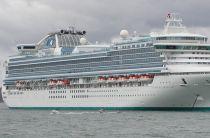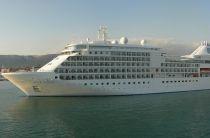Strait of Magellan (Chile)
Cruise Port schedule, live map, terminals, news
Region
South America
Local Time
2025-04-17 16:19
 49°F
49°F 9.2°C

 Light breeze
Light breeze2.6 m/s
 52 °F / 11 °C
52 °F / 11 °C 44 °F / 7 °C
Port Strait of Magellan cruise ship schedule shows timetable calendars of all arrival and departure dates by month. The port's schedule lists all ships (in links) with cruises going to or leaving from Strait of Magellan, Chile. To see the full itineraries (ports of call dates and arrival / departure times) and their lowest rates – just follow the corresponding ship-link.
| Day | Ship | Arrival | Departure |
|---|---|---|---|
| 14 December, 2025 Sunday | |||
| 25 December, 2025 Thursday |
Strait of Magellan (aka Straits of Magellan) is a navigable sea channel between South America's mainland (at Punta Dungeness) and Antarctica's Tierra del Fuego (at cape Cabo del Espíritu Santo). This is an important (natural) sea passage between the Atlantic and Pacific. However, due to its unpredictable harsh weather (strong winds and water currents) and its narrowness, the Magellan Strait is considered difficult to navigate through. Along with the Drake Passage and Beagle Channel, these are the only navigable sea passages around South America.
- The strait is named after the Portuguese explorer Ferdinand Magellan (1480-1521) who during the reign of Charles I of Spain (in 1520) became the first European navigating through the strait on an around the world (circumnavigation) itinerary. The expedition voyage started in Valladolid Spain (on March 22, 1518). The fleet consisted of 5 sail ships and departed from Sanlúcar de Barrameda in 1519 (on Sept 20). The vessels were named La Trinidad (55 crew), La San Antonio (60 crew), La Concepción (45 crew), La Victoria (42 crew) and La Santiago (32 crew). The ships entered the strait in 1520 (on Nov 1). The strait was originally named Estrecho de Todos los Santos (translated "Strait of All Saints"). Other (alternative) names were Patagonian Strait and Victoria Strait. Since 1527, it was called Estrecho de Magallanes.
- Strait of Magellan has length of approx 570 km (350 ml) and width of approx 2 km (1,2 ml) at Carlos III Island (its narrowest point). The strait's northwest part is similar to the Alaska's Inside Passage. The strait's western part goes northwest from Magdalena Channel's northern end to the Pacific Ocean.
- This is a well protected (safe) inland waterway, with the shipping route running through Beagle Channel. All the shipping traffic between mainland Chile and Argentina runs through the Magellan Strait, connecting their Tierra del Fuego cities - Porvenir (Chile), Cerro Sombrero (Chile), Timaukel (Chile), Ushuaia (Argentina) and Rio Grande (Argentina). Statistical data for 2008 shows 571 Chilean cargo ships and 1681 non-Chilean marine vessels have sailed through the strait. Under the 1984's Treaty of Peace and Friendship between Argentina and Chile, marine vessels (including cruise ships) of other nations are allowed to navigate these waters only with a Chilean pilot on board.
- There 41 listed lighthouses in this waterway, some of which are over 100 years old and declared national monuments. Among those are County of Peebles (iron-hulled rig ship, now used as a breakwater for the Punta Arenas' harbour), San Isidro (now a museum) and Evangelistas (at the strait's western mouth):
- Around the strait are located the following protected park areas - Cabo Posesion (cape), Cabo Espíritu Santo (cape), San Gregorio, Estepa Humeda, San Juan, Río Condor, Timaukel, Dawson Island, Cabo Froward (cape), Munoz Gamero (península), Carlos III Island, Rupert Island.
The Strait of Magellan was taken by Chile in May 1843, fearing an occupation by France or Great Britain. The Chile's first settlement here was named Fuerte Bulnes (on the strait's northern side). In 1881, Argentina recognized the strait's Chilean sovereignty. Steamships strarted navigation through the strait in 1840. Until the Panama Canal's opening (1914), Strait of Magellan was the main shipping route between the Atlantic and Pacific. The Punta Arenas port became a primary refueling point along the route. At the port were provided coal for the transiting steamships. However, due to unpredictable strong winds and water currents in the strait, sail ships preferred passing trough Drake Passage.
Strait of Magellan alternatives for ship crossings between Atlantic and Pacific oceans are the Panama Canal (Central America) and the Northwest Passage (in the Canadian Arctic territories).
- Cruise Industry

Princess Cruises opens bookings for South America & Antarctica 2024-2025 season
The luxury travel brand Princess Cruises opened for booking an array of captivating voyages scheduled for South America and Antarctica season 2024...
August 8, 2023 - Cruise Industry

HAL-Holland America Line’s 2022-2023 Grand Voayges (Africa, South America and Antarctica, World...
Three HAL-Holland America Line's World Cruises - Grand Africa Voyage 2022, Grand World Voyage 2023, and Grand South America and Antarctica Voyage...
January 27, 2021 - Cruise Industry

Silver Whisper 2020 World Cruise Visits All 7 Continents
On March 12, 2018, Silversea opened for booking MS Silver Whisper's 140-day "World Cruise 2020". The itinerary visits 62 ports in 32 countries, and...
March 13, 2018 - show more news
